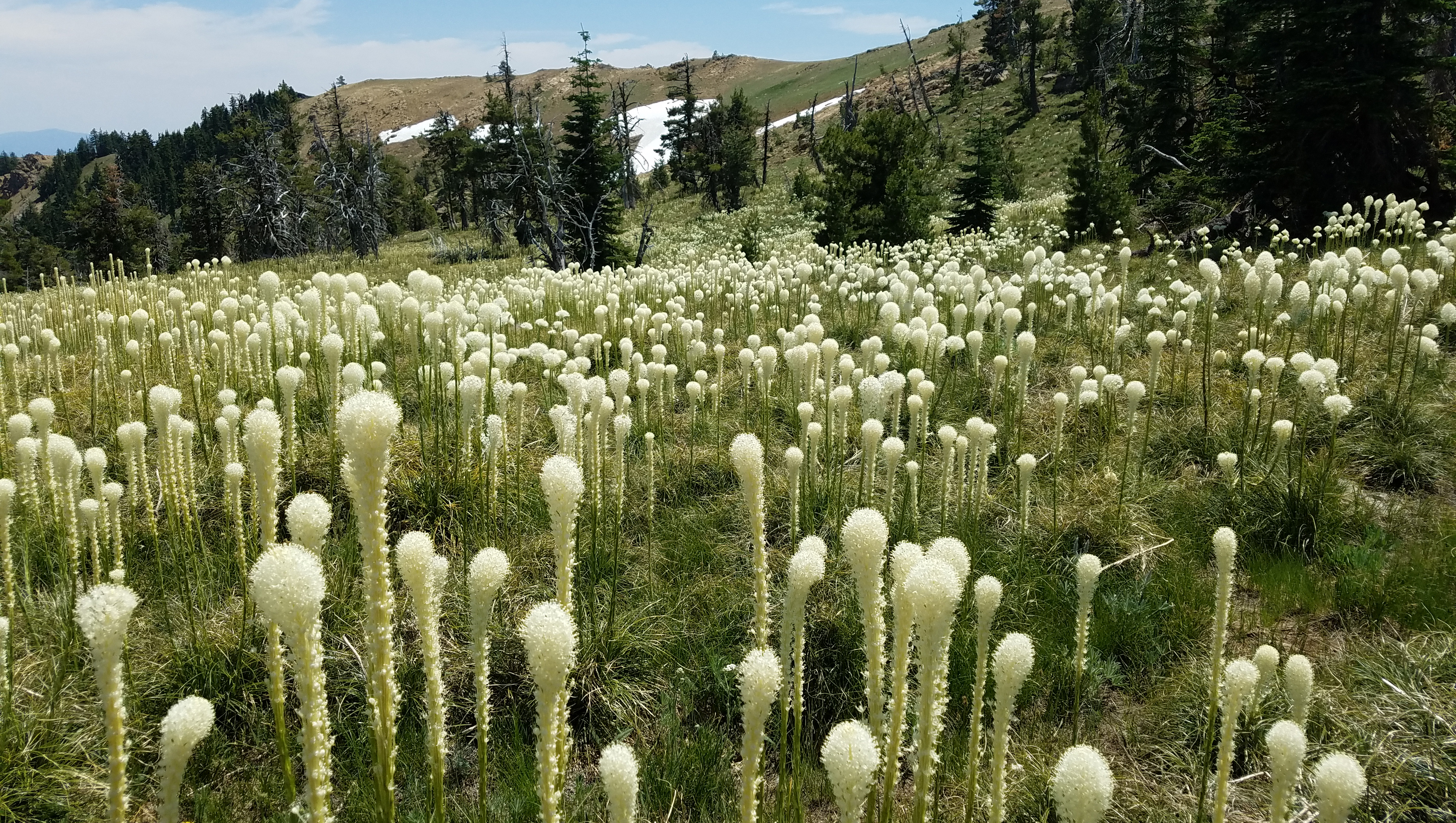NPSO 2019 Annual Meeting
July 12-14 Klamath-Siskiyou Mountains
Field Trips
Saturday July 13, 2019 8:30 - 4:00 Field Trip # 14
Big Red Mountain PCT TRIP IS FULL
 Beargrass Heaven on Big Red Mountain.
Beargrass Heaven on Big Red Mountain.
Difficulty: Moderate (Approximately 7-8 miles) - Distance may be less if we stop frequently to botanize. The trail has rocky and uneven footing in places.
Elevation: Starting elevation is 6000 ft., with approximately 700-1000 ft. elevation gain.
Group Size Limit: 15
Hiking the PCT on Big Red Mountain
Trip Description: Big Red Mountain is located on the boundary between the Rogue River-Siskiyou National Forest and Klamath National Forests on the eastern Siskiyou Crest within the Big Red Mountain Botanical Area.
Big Red Mountain is part of the serpentine Siskiyous with unique geology and ultramafic soils hosting some beautiful endemic plants. This stretch of the PCT traverses outcrops of serpentinite and open ridgelines, meanders through subalpine meadows and under canopies of Siskiyou Crest Abies hybrids.
We will see the rare and showy Epilobium siskiyouense (Siskiyou willow herb) in bloom, three types of sword fern: Polystichum lemmonii (Lemmon's sword fern), Polystichum imbricatum, (imbricate sword fern, and Polystichum munitum (western sword fern), also Pinus monticola (western white pine), and dense fields of Xerophyllum tenax (bear grass), as well as classic montane denizens such as thickets of Prunus emarginata (bitter cherry), pollinator pleasing Agastache urticifolia (nettle leaved horsemint), and swathes of Veratrum californicum (California corn lily).
We will caravan to the Wrangle Gap PCT trailhead and spend about half an hour getting an overview of serpentine Siskiyou geology from geologist Jad D'Allura. We will then hike the PCT toward Big Red Mountain, exploring geology and botanizing along the way, hopefully making it to the Epilobium siskiyouense patch in the serpentine outcrop.
Floristic Highlights: Castilleja schizotricha, Horkelia hendersonii, Epilobium siskiyouense, Lewisia leana, Erigeron petrophilus, Astragalus whitneyi var. siskiyouense, Dicentra uniflora, Allium siskiyouense, Triteleia crocea
Appropriate Footwear: Sturdy footwear is advised.
Special Considerations: High clearance vehicles are recommended but not required.
No facilities at the trail head. There is a pit toilet at Wrangle Camp.
We will be on a high elevation ridge with sun and wind exposure. Prepare and stock your vehicle and backpack appropriately. Bring sun protection, extra water and snacks; binoculars and cameras are welcome. You can fill your gas tank in Murphy, Williams, or Applegate. Bring trekking poles if you use them.
Meeting Place and Time: Trip # 14 leaves at 8:30am from Pacifica.
Alternate Meeting:
To accomodate trip members who aren't staying at Pacifica, this trip will also pick up members at its first stop at Star Ranger Station at 9am, (6941 Upper Applegate Road).
Driving Directions: Directions to Wrangle Gap and the Big Red Mountain PCT Trailhead:
From Pacifica, head right (southerly) across the Applegate River and through the town of Applegate on HWY 238 about 18 miles. Turn right on Hamilton and go past Cantrall-Buckley County Park. Turn right on Upper Applegate Road 7.5 miles to Beaver Creek Road (Road 20) and turn left. Eventually Road 20 turns to gravel. Turn left at the Silver Fork Gap intersection, still on Road 20, towards Dutchman Peak. At Jackson Gap turn left on Road 20 and head (north) to the PCT parking area at Wrangle Gap. Note: Road 20 contains washboard sections and is a bit rough and narrow near Dutchman Peak; it is still passable in regular cars, although best in AWD or 4WD.
Driving miles from Pacifica to trailhead: 40 miles one way from Pacifica. (Drive time about 1 hour and 25 minutes.)
Leaders: Rachel Werling & Dr. Jad D'Allura
Rachel Werling is the Land Steward and Oregon Master Naturalist Klamath-Siskiyou Ecoregion Coordinator for Jackson County Extension. She has a bachelor's degree in environmental biology, and a minor in Botany from Humboldt State University and a masters in Plant Biology from Arizona State University. Her master's thesis is an illustrated flora of native trees and shrubs of the central valleys of Oaxaca, Mexico and included species new to science. She has worked with birds, mammals, riparian systems and, most extensively, plants. Rachel has worked as contracting field botanist in the Pacific Northwest since 2006. She is deeply addicted to phyto-endorphins and loves to share them with others.
Dr. Jad D'Allura earned his Ph.D. in geology at the University of California, Davis. He worked two years in L.A. for Texaco as an exploration geologist and then spent 33 years teaching geology at Southern Oregon University before the degree was eliminated. During his tenure at SOU he worked on the geology of the Cascade-Siskiyou National Monument. He has also done work in metamorphic rocks of the Siskiyou Mountains. He continues to work on the Monument with University of Oregon students, as well as give talks and hikes to push back the veil of geologic obliviousness.
.jpg) Siskiyou fireweed (Epilobium siskiyouense)
Siskiyou fireweed (Epilobium siskiyouense)
Big Red Mountain
Looking at botany and geology in a serpentine meadow on Big Red Mountain.
Lee's lewisia (Lewisia leana)
The view from Big Red Mountain.



